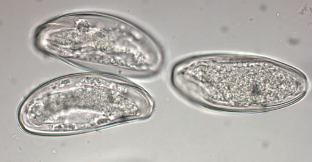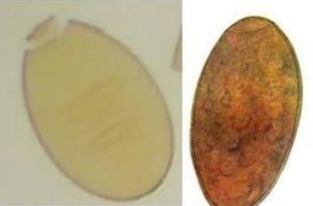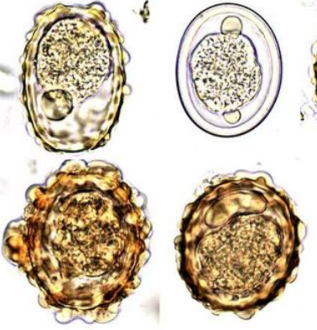Worms – is the scientific name of parasite worms. How do the eggs of tapeworms, of interest to many, because they are guests in our body. You live in the organisms of humans, animals and plants. Most of these parasites has long been adapted to life on open fresh air, earth and water. Their eggs are floating in the earth, in the water, and even in the air.

Some information about this Helminthiasis
Today, more than 300 species of worms, of which 70, living on the territory of our country. The world health organization worm infestations of the most important infections. The number of infected by the worm may vary from 20 to 22 million people.
To helminth 3 classes are as worms:
- Flatworms (tapeworms) – for a very long time, feeding from the blood of the host. Most commonly cattle and pigs, taenia, Echinococcus.
- Roundworms (nematodes) – have different sizes, dioecious. The most common are roundworms and pinworms.
- Trematody – always bisexual biohelminths, on the head have suction cups, with the aid of which the worm attaches itself to the organs of the host. To do this, schistosomiasis, and others.
The presence of worms is dangerous for several reasons:
- Parasites are able to apply mechanical damage to internal organs;
- the disorder of the metabolism;
- Products of vital activity of the worms to poison the organism of the host;
- the provoking presence of worms is capable of other diseases.
Worms lay eggs, which enter the body usually through the digestive (with food or water), or in the case of non-compliance with the hygiene standards.
Description of the appearance and the shape of the well-known helminths
| Helminths | Look | Construction |
| Pinworms | These small round worms are white in color, your size is usually not more than 1 cm. | On the front of the body pinworms vesicles is located. With your help, helminth is within the intestine, causing mechanical damage. The other end of the worm is sharpened. Hence the name pinworm. |
| Thread worm | A fairly large worm, with a length of about 20 cm and width 6 mm. the females much larger than males. It is red-white color with a curved tail. | Body thread worm covered with solid cuticle, which solves even the gastric juice. At the end of the nematode has the mouth, the mouth with three lips.
Directly behind the mouth in the body of the thread worm of the esophagus and the intestines, consisting of a straight tube. Parasites remains the only ready-made food to swallow and digest. |
| Whipworm | The little worm. In the length up to 5 cm, and the width no thicker than a human hair, not more than 0.5 mm. The sharp end, clings to them for the mucous membranes. | The front end of the worm (3-5 cm), precious to the thickness of the hair. The rear end fatter than the front. Therein is placed the bowel. The female has in the rear end, there are the uterus. |
| Toxocara | In its size, Toxocara, up to 10 cm in length. The males are smaller.
|
Toxocara worm-and-white. Body oblong, similar to a thin cylinder. Opening of the mouth has three lips. |
| Trichinella | Refers to the round worms in small sizes. In the length of not more than 5 mm. | Its main distinctive feature of the construction is one-sided gastro-intestinal tract. |
| Bullish tsepen (tapeworm) | The worm is very large. Has a long body in the Form of a tape. How many meters in length reached bullish tsepen?! He gigantic proportions of up to 30 meters! | Skoleks (head) has 4 strong suction cups without hooks. The head of the tapeworm is small. On the neck of members grow, their number is from 1 to 2 thousand. The Uterus is developed, filled with translucent eggs. In the case of spawning tapeworm segments tire separated, move in with faeces, or separately from the intestines to go outside. |
| Swine tsepen
(Tape worm) |
Its shape is very similar to bullish tapeworm. But, according to the sizes he several times less for cattle tape-worm, not more than 3-5 m. | Pork tapeworm armed tsepnem is called. He has, except on the head, 4 suction cups, a 32 hook. Segments of the tapeworm have about 50 thousand eggs. |
| Lentets Wide | Still a long worm, its length can be more than 10 m. | The body of the snail consists of a small, flat-head, not more than 5 mm from two sides, there is the long, flat slot-sucker. You worm sticks to the walls of the intestine. |
| Echinococcus | Belongs to the class of tape worms, helminth small sizes. On his head has a hook and suction cups. | Echinococcus consists of 3-4 segments. "Armed" parasite suckers and hooks. In segments of the parasite are the sex organs, and in the third egg. You can separate your members, and have the ability to move themselves. |
| Opisthorchiasis small | Little worm, in size up to 1 cm On the head of the oral sucker. | The worm has 2 suction cups that are fixed on a smooth surface. There are oral and the ventral suckers. From the mouth sucker swallowing, and behind it are the oesophagus and the intestine goes. In the rear end in the case of parasites, there is the secretory Organ. |

Characteristics of the life cycle of the worms
The duration of the life span of the worms otherwise. For some, it may take a year or two, and in the case of other parasites more than 10-15 years! So among the helminths old has his hundred. For example, pinworms life is not long, not more than 6 months. Fertility is high enough. In view of the fact that the eggs of pinworms are very easy, you can even in the air we breathe.
The eggs of the roundworms and whip worms get into the body through the food
Roundworm and whipworm life more than 2 years. The first live up to 2 years, and the last for 3-4 years. But that's not the terrible numbers!
And here is the record-holder is among the worms, which cause enormous damage in the human organism is swine tsepen. Its life span is up to 20-30 years!
Experts provided various experiences and experiments with the worms, to the conclusion that the temperature of the habitats affect the behavior of the worm. If the temperature of the body, the patient's Ascaris to leave spontaneously the body. Thus, at a temperature of 40°C, the activity of the nematode increased several times.
The lowering of the temperature in the environment is forcing worm measures – ejection from the body.
A method of disinfection, the thermal treatment is. For example, in a fish-parasite died, enough to cook it for 30 minutes. Freezing at different temperature ranges to speed up the process of treatment. At a temperature of -15°C, the duration of the Frost – 30 days. At -35°C – enough to 10 hours.
How many degrees need to decontaminate the treatment unit products? Eggs of roundworms die at a temperature of +55°C. the processing of toys in the water at a temperature of +70°C for a few seconds.
The back of the eggs deworm
Most of the parasites lay their eggs, but among them there are also live-bearing worms. These are Trichinella.
How do the eggs of worms can learn only with the aid of the microscope. What kind of worms "done" in the people, you can determine, after treatment of the eggs. And the larva with the naked eye.
The female of the worm stays in the body up to the time of fertilization and during pregnancy and offspring
How many eggs can be horrified to move the female worm. Toxocara able to move a day, 250 thousand eggs. By the way, larvae and worm eggs are much tough than adults. The females of some of the worms die after her eggs drop, so pinworms from happening.
Parasites in every class of life in their own way, reproduce and lay eggs. For example, biohelminth the eggs and larvae in the body of the host (cow, cat, dog) tires. For example, biohelminth swine tsepen. If in the human body the larva then passes the tapeworm grows in the small intestine. In the case of an infection, tapeworm eggs the thing is even worse. You can wander through the entire body, and can settle in any Organ. In the case of geohelminths eggs and larvae to Mature outside of the body of the host must, in the soil. Roundworm eggs develop into larvae in the small intestine. And under good conditions, and with the blood of eggs (larvae) ascarids Hiking in all the organs.
| Helminths | Description of the eggs | The number of masonry | The duration of the maturation |
| Pinworms | Egg pinworms asymmetric oval in shape. Shell smooth, consisting of several layers of colorless. In fertilized eggs, a larva already included. | Ripen at a time pinworms no more than 10-15 thousand eggs. | After the oviposition of the female, larva in them for 6-8 hours to ripen later. |
| Thread worm | Egg is not fertilized, it has an oval elongated shape. The outer shell is dense, with a small tubercle. The interior of the eggs filled with yellowish cells. | Every day, more than 250 single thousand eggs. | After 2-3 weeks, the fertilized eggs are non-invasive. |
| Whipworm | The egg of this parasite has the shape of a barrel, its coat is multi-layered and transparent. The interior of the eggs has small grains. | 3500 immature eggs per day | You need 2 weeks for the maturation of the larva. |
| Toxocara | Eggs with a thick, fine-textured shell. | 200 thousand eggs per day. | After a few days the larvae Mature in the eggs. You will be invasive. |
| Trichinella | The size of the larvae of 0.1 mm. | 2 months, the female gives birth to more than 2,000 larvae. | The female Trichinella-living larvae, gives birth. |
| Bullish tsepen (tapeworm) | The egg of the shape of the Oval bubble is gray, has two appendages. | Cyst contains about 200 thousand eggs. If the body is not a cyst, it needs an enormous number of eggs. | Cysticerci in the muscles to keep life within 3 years. |
| Lentets Wide | Eggs Oval, with smooth shell yellow. The top of the eggs cover, from below tubercle. | Every day, people with feces raises several million eggs. | After 2-3 days in the eggs, the larva is formed. |
The life of worms outside of the human
The worms can live not only in the human organisms and animals, but also outside of the host For example, Giardia in cats, settle in the upper part of the colon, and also you find yourself at the river fish (bream, pike-perch).
The eggs of the parasite pinworm is so simple that you will be able to be in the air. Infected deworm and the water. She is from the affected floors. From the water the fish in the pond.
On the plants helminths sometimes. On you para only nematodes parasitize. Beat roots and tubers of plants, but also stems and leaves. The infection occurs through the digestive host swallows the eggs of the worms with food. If the products are Parboiled, then die, the eggs and the larvae.

The life cycle of the worm on the example of pinworms
In the human body, the pinworm only a few intestinal: Department lives in the small intestine, cecum, and the upper section of the colon.
Invasion for the people of the egg with larva. The host is the faecal-oral route. The larva frees itself from the protective shell in the small intestine and migrates to the points of localization. Next, the process called molting comes after the larva is more advanced animal.
Helminths — multi-celled parasites
After mating, the males will die from the body with feces. Meanwhile, the female is with the help of the vesicles is on the skin of the intestinal mucosa, in you the eggs to Mature. You are very fertile in the uterus for more than 10-15 Matures thousands of eggs. In the maturation of the eggs, the females move to the Anal hole. The female outside of the intestine in the night, when the muscles of the Anus relaxed. She crawls through the folds of the skin of the external genitalia. The muscles of the Vagina of the female relaxes, and begins to release eggs. On the surface of the skin of the body of the host, the most favorable conditions: temperature, moisture, oxygen. How to ripen an egg?
After 6-8 hours within the egg, outside of the people who make up the larvae, they are invasive.
Further, the female dies, dries up, forms clumps. Of your movements wrinkles is itching. The host is combing this area. On the hands and under the nails of the eggs of the parasite appeared. Then there are several possibilities:
- The Patient, not the observance of rules of personal Hygiene, infected again. The Breakfast with unwashed hands.
- The Patient infected hands touched household items, toys, door handles, etc., their family members, infect.
Remember that the host of any helminth will not be able to reproduce and develop. The egg or the larva of the host is not necessarily a cycle: the host-to-ground/air.





































